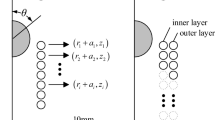Abstract
Experimental and computational methods are used to optimize the electrostatic field for levitating metallic materials. The calculated launch voltage increases linearly with the distance between top and bottom electrodes. The combination of a larger top electrode diameter with a smaller bottom diameter may enhance the levitation ability because the electric field intensity near the levitated sample is strengthened. Top convex and bottom concave electrodes can guarantee good levitation stability but decrease the levitation force. The design of bottom electrode is crucial to attain not only a stable levitation state but also a higher levitation capability. As a measure characterizing the intrinsic levitation ability of various materials, the product of density and diameter of levitated samples can be used to determine the launch voltage for counteracting gravity according to a power relationship.
Similar content being viewed by others
References
Wert M J, Hofmeister W H, Bayuzick R J. Effect of dilute amounts of oxygen solute on nucleation of zirconium. J Appl Phys, 2003, 93(6): 3643–3651
Chathoth S M, Damaschke B, Samwer K, et al. Thermophysical properties of Si, Ge, and Si-Ge alloy melts measured under microgravity. Appl Phys Lett, 2008, 93: 071902
Aoyama T, Kuribayashi K. Novel criterion for splitting of plate-like crystal growing in undercooled silicon melts. Acta Mater, 2003, 51: 2297–2303
Kelton K F, Lee G W, Gangopadhyay A K, et al. First X-ray scattering studies on electrostatically levitated metallic liquids: Demonstrated influence of local icosahedral order on the nucleation barrier. Phys Rev Lett, 2003, 90(19): 195504
Brillo J, Pommrich A I, Meyer A. Relation between self-diffusion and viscosity in dense liquids: New experimental results from electrostatic levitation. Phys Rev Lett, 2011, 107: 165902
Mauro N A, Kelton K F. A highly modular beamline electrostatic levitation facility, optimized for in situ high-energy x-ray scattering studies of equilibrium and supercooled liquids. Rev Sci Instrum, 2011, 82: 035114
Rhim W K, Chung S K, Barber D, et al. An electrostatic levitator for high-temperature containerless materials processing in 1-g. Rev Sci Instrum, 1993, 64(10): 2961–2970
Rulison A J, Watkins J L, Zambrano B. Electrostatic containerless processing system. Rev Sci Instrum, 1997, 68(7): 2856–2863
Ishikawa T, Paradis P F, Yoda S. New sample levitation initiation and imaging techniques for the processing of refractory metals with an electrostatic levitator furnace. Rev Sci Instrum, 2001, 72(5): 2490–2495
Félici N J. Forces et charges de petits objets en contact avec une électrode affectée d’un champ électrique. Rev Gén Elec, 1966, 75(10): 1145–1160
Pérez A T. Charge and force on a conducting sphere between two parallel electrodes. J Electrostat, 2002, 56: 199–217
Colver G M. Dynamic and stationary charging of heavy metallic and dielectric particles against a conducting wall in the presence of a dc applied electric field. J Appl Phys, 1976, 47(11): 4839–4849
Novick V J, Hummer C R, Dunn P F. Minimum dc electric field requirements for removing powder layers from a conductive surface. J Appl Phys, 1989, 65(8): 3242–3247
Wu Y, Castle G S P, Inculet I I, et al. Induction charge on freely levitating particles. Powder Tech, 2003, 135–136: 59–64
Jackson J D. Classical Electrodynamics. New York: Wiley, 1973
Hu L, Wang H P, Xie W J, et al. Electrostatic levitation under the single-axis feedback control condition. Sci China-Phys Mech Astron, 2010, 53(8): 1438–1444
Okada J T, Ishikawa T, Watanabe Y, et al. Viscosity of liquid boron. Phys Rev B, 2010, 81: 140201 (R)
Sridharan G, Chung S, Elleman D, et al. Optical sample-position sensing for electrostatic levitation. Proc. of the SPIE-Meeting, Orlando, USA, 1989, 1118: 160–164
Author information
Authors and Affiliations
Corresponding author
Rights and permissions
About this article
Cite this article
Hu, L., Wang, H., Li, L. et al. Geometric optimization of electrostatic fields for stable levitation of metallic materials. Sci. China Technol. Sci. 56, 53–59 (2013). https://doi.org/10.1007/s11431-012-5071-7
Received:
Accepted:
Published:
Issue Date:
DOI: https://doi.org/10.1007/s11431-012-5071-7




